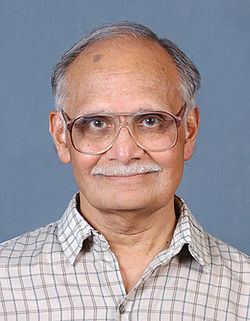Name A. Balachandran | Alma mater Madras Fields Physicist Role Physicist Notable students Pierre Ramond | |
 | ||
Residence Syracuse, New York; Kerala, India Books Lectures on Fuzzy and Fuzzy SUSY Physics | ||
Algebraic Quantum Physics:Entropy and Entanglement, A. P. Balachandran 22/11/2018
Aiyalam Parameswaran Balachandran (born 25 January 1938) is an Indian theoretical physicist well known for his extensive contributions to the role of classical topology in quantum physics. He has been the Joel Dorman Steele Professor of Physics in Syracuse University since 2000. He has also been a Fellow of the American Physical Society and awarded a prize by the U.S. Chapter of the Indian Physics Association in recognition of his outstanding scientific contributions. In 1990, Syracuse University honored him with a Chancellor's Citation for Exceptional Academic Achievement.
Contents
- Algebraic Quantum PhysicsEntropy and Entanglement A P Balachandran 22112018
- FTAG XI Day 4 Seminar 3 Dark Radiation from Infrared gravitons A P Balachandran
- Early life and education
- Research
- Books
- References
FTAG-XI: Day 4, Seminar 3: Dark Radiation from Infrared gravitons - A. P. Balachandran
Early life and education
Balachandran was born on 25 January 1938 in Salem, Tamil Nadu, India. His Father Aiyalam Sundaram Parameswaran was a chartered accountant in Pierce Leslie and Company in Cochin. Balachandran had a gifted poet, Vyloppilli Sreedhara Menon, as his teacher. Balachandran completed his first two college years in Guruvayurappan College, Kozhikode specialising in physics, chemistry and mathematics and passing the 'Intermediate Examination' with all-State distinction in 1953. He joined B.Sc.(Hons) in Physics in the Madras Christian College, Tambaram, Chennai. Balachandran passed out of MCC in 1958.
Research
Balachandran did his PhD under Professor Alladi Ramakrishnan at the University of Madras. Then he joined Theoretische Physik, Universitaet Wien as a postdotoral fellow under Prof. Walter Thirring, subsequently at the Enrico Fermi Institute as a postdoc. In 1964, he joined the Syracuse University faculty. Balachandran's key scientific works to date include the revival of the Skyrme model which successfully describes baryons as topological solitons of meson fields and mathematical concepts such as homotopy groups and fibre bundles to problems in quantum physics. In recent, Balachandran's research has been focused on the formulation of quantum field theories on noncommutative spacetimes and investigating the emergent significance of Hopf algebras in quantum physics as generalisations of symmetry groups.
